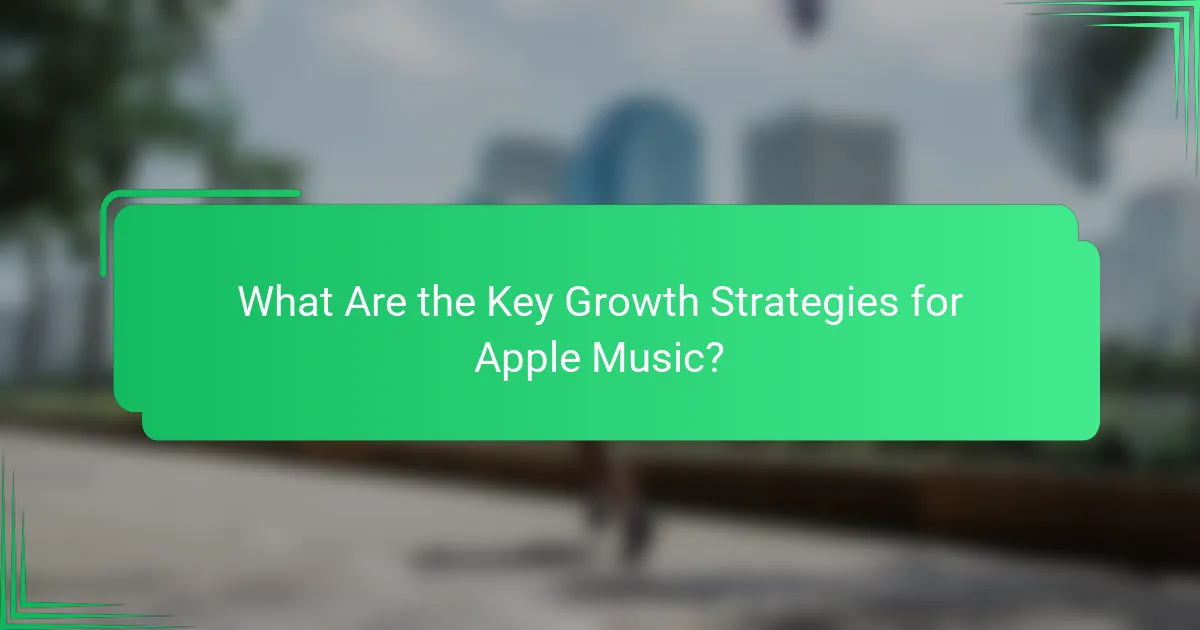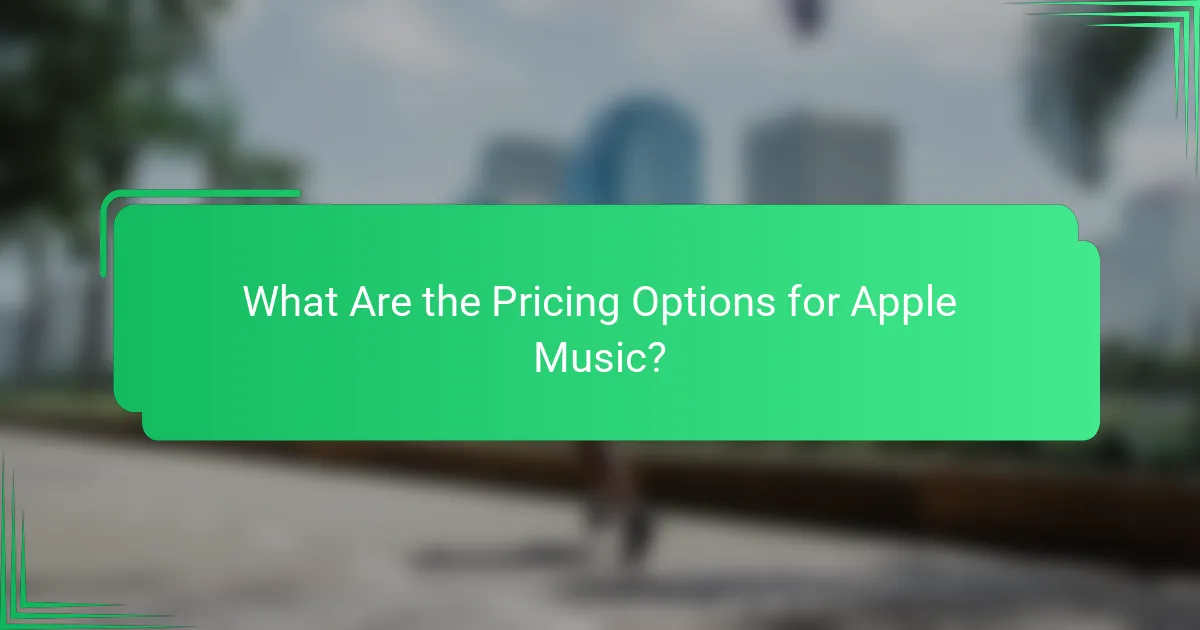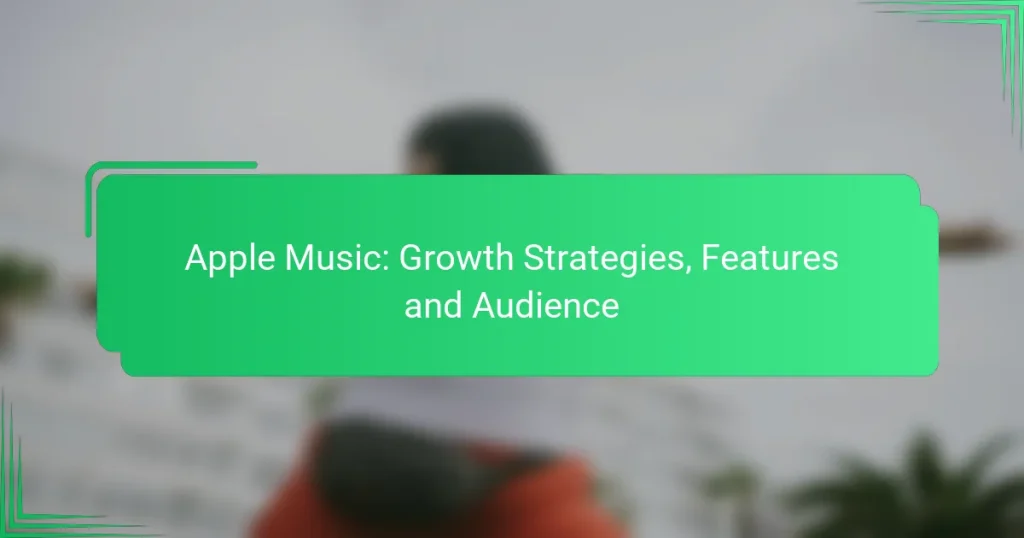Apple Music has rapidly grown its user base by implementing strategic partnerships, offering exclusive content, and launching targeted marketing campaigns. Its unique features, such as personalized playlists and high-quality audio streaming, cater to a diverse audience that includes young adults and music enthusiasts. By integrating seamlessly with the Apple ecosystem, Apple Music enhances the listening experience for both casual listeners and dedicated fans alike.

What Are the Key Growth Strategies for Apple Music?
Apple Music employs several key growth strategies to expand its user base and enhance its service offerings. These strategies include partnerships with artists, exclusive content, targeted marketing campaigns, global expansion, and competitive pricing models.
Partnerships with Artists
Apple Music actively collaborates with artists to create unique promotional opportunities. These partnerships often involve exclusive interviews, behind-the-scenes content, and special performances that are only available on the platform. By aligning with popular musicians, Apple Music enhances its brand visibility and attracts their fan bases.
For example, Apple Music has hosted exclusive live events featuring major artists, which not only boosts engagement but also encourages new subscriptions. Such collaborations can significantly enhance user loyalty and retention.
Exclusive Content and Releases
Offering exclusive content is a major strategy for Apple Music to differentiate itself from competitors. This includes early access to new albums, unique playlists, and original shows that cannot be found on other platforms. Such exclusive offerings create a sense of urgency and excitement among users.
Apple Music has successfully launched exclusive album releases from top artists, which can drive significant traffic and subscriptions during these events. This strategy not only attracts new users but also keeps existing subscribers engaged.
Targeted Marketing Campaigns
Apple Music utilizes targeted marketing campaigns to reach specific demographics effectively. By leveraging data analytics, the platform can tailor its advertising to resonate with different audience segments, ensuring higher conversion rates. Campaigns often highlight new features, exclusive content, or artist partnerships.
For instance, Apple Music may run campaigns focusing on specific genres or artists that appeal to particular age groups or cultural backgrounds, maximizing their marketing impact and driving user acquisition.
Global Expansion Efforts
Apple Music is committed to expanding its presence in international markets. This involves localizing content to cater to regional tastes and preferences, which can significantly enhance user engagement. The service has launched in various countries, adapting its offerings to include local artists and genres.
As part of its global strategy, Apple Music often collaborates with local music labels and artists to curate playlists that resonate with specific audiences, making the platform more appealing in diverse markets.
Competitive Pricing Models
To attract a wider audience, Apple Music employs competitive pricing models that often include family plans, student discounts, and promotional offers. These pricing strategies make the service accessible to a broader range of consumers, from students to families.
For example, Apple Music’s student plan offers significant discounts compared to standard subscriptions, which can encourage younger users to sign up. Additionally, promotional trials allow potential subscribers to experience the service before committing financially, further boosting user acquisition.

What Features Make Apple Music Stand Out?
Apple Music distinguishes itself through a combination of personalized playlists, high-quality audio streaming, seamless integration with the Apple ecosystem, live radio stations, and robust music sharing options. These features enhance user experience and cater to diverse listening preferences.
Personalized Playlists
Apple Music offers personalized playlists that adapt to your listening habits, making it easy to discover new music. The “For You” section curates playlists based on your favorite genres, artists, and songs, ensuring a tailored experience.
Additionally, the platform frequently updates these playlists, so users can enjoy fresh content regularly. This dynamic approach keeps the listening experience engaging and relevant.
High-Quality Audio Streaming
Apple Music provides high-quality audio streaming, supporting lossless audio and spatial audio with Dolby Atmos. This feature allows listeners to enjoy music with enhanced clarity and depth, making it ideal for audiophiles.
Users can choose between standard and high-resolution audio settings, giving them control over their streaming quality based on their internet connection and device capabilities.
Integration with Apple Ecosystem
Apple Music seamlessly integrates with the Apple ecosystem, allowing users to access their music across various devices, including iPhones, iPads, Macs, and Apple Watches. This integration enhances convenience and ensures a consistent experience.
Features like Siri voice commands enable hands-free control, making it easy to play, pause, or skip tracks without needing to interact directly with the device.
Live Radio Stations
Apple Music includes live radio stations, such as Beats 1, which features a mix of music, interviews, and exclusive content. These stations provide a unique listening experience that goes beyond traditional playlists.
Listeners can tune in to various genres and discover new artists through curated shows, making it a valuable resource for music enthusiasts looking to explore beyond their usual preferences.
Music Sharing Options
Apple Music offers robust music sharing options, allowing users to share playlists and songs with friends and family easily. This feature fosters community engagement and enhances the social aspect of music discovery.
Users can share their favorite tracks via social media or directly through messaging apps, making it simple to recommend music and collaborate on playlists with others.

Who Is the Target Audience for Apple Music?
The target audience for Apple Music primarily includes young adults, music enthusiasts, Apple product users, and casual listeners. This diverse group values high-quality music streaming, exclusive content, and seamless integration with Apple devices.
Young Adults and Millennials
Young adults and millennials form a significant portion of Apple Music’s user base, often seeking platforms that offer trendy music and social sharing features. They appreciate curated playlists and personalized recommendations that align with their diverse musical tastes.
This demographic typically engages with music through mobile devices, making Apple Music’s app functionality and user experience crucial for retention. Promotions and student discounts can also attract this age group, enhancing accessibility.
Music Enthusiasts
Music enthusiasts are deeply passionate about discovering new artists and genres, making them a key audience for Apple Music. They often seek high-fidelity audio quality and exclusive releases, which Apple Music provides through its extensive library and curated playlists.
This group values features like lossless audio and spatial audio, enhancing their listening experience. Engaging with music documentaries and artist interviews can further captivate this audience, fostering loyalty to the platform.
Apple Product Users
Apple product users are naturally inclined to subscribe to Apple Music due to its seamless integration with devices like iPhones, iPads, and Macs. This audience benefits from features such as Siri voice commands and cross-device syncing, enhancing convenience.
Exclusive features for Apple users, such as Family Sharing plans and integration with Apple Watch, make the service particularly appealing. The ecosystem approach encourages users to remain within the Apple brand for their music needs.
Global Audience Segments
Apple Music targets a global audience, adapting its offerings to various regions. This includes localized content, language support, and region-specific playlists that resonate with different cultural tastes.
In markets like Europe and Asia, Apple Music competes with local streaming services by offering unique features and exclusive partnerships with artists. Understanding regional preferences is essential for effective marketing and user engagement.
Casual Listeners
Casual listeners are those who enjoy music but do not actively seek out new releases or deep dives into artist catalogs. Apple Music caters to this group with user-friendly playlists and radio stations that simplify music discovery.
Features like the “For You” section and easy access to popular charts help casual listeners find music that suits their mood without extensive searching. Offering a free trial can entice this audience to explore the platform further without commitment.

How Does Apple Music Compare to Competitors?
Apple Music offers a robust music streaming experience that stands out against competitors through its integration with the Apple ecosystem, exclusive content, and curated playlists. While it shares similarities with other platforms, each service has unique features that cater to different user preferences.
Comparison with Spotify
Spotify is known for its extensive library and personalized playlists, making it a favorite among many users. Apple Music, however, excels in its seamless integration with Apple devices and exclusive releases from popular artists. Users often appreciate Spotify’s free tier, while Apple Music requires a subscription, typically around $10 per month.
Comparison with Amazon Music
Amazon Music offers a variety of subscription options, including a free tier for Prime members. In contrast, Apple Music focuses on a single subscription model that provides access to its entire library without ads. While Amazon Music has a broader range of audio formats, including HD and Ultra HD, Apple Music emphasizes curated playlists and radio shows, appealing to users who prefer a more guided listening experience.
Comparison with YouTube Music
YouTube Music stands out with its vast collection of music videos and user-generated content. Apple Music, on the other hand, prioritizes audio quality and exclusive artist content. While YouTube Music is free with ads, Apple Music’s subscription model offers an ad-free experience, which many users find preferable for uninterrupted listening.

What Are the Pricing Options for Apple Music?
Apple Music offers several pricing options tailored to different user needs, including individual, family, and student plans. Each plan provides access to the full catalog of music, playlists, and exclusive content, with varying costs based on the number of users and eligibility.
Individual Subscription Plans
The individual subscription plan for Apple Music typically costs around $10 to $15 per month, depending on the region. This plan allows one user to access the entire music library, create playlists, and enjoy personalized recommendations.
Users can also take advantage of a free trial period, usually lasting about one month, to explore the service before committing. It’s advisable to check for any promotional offers that may reduce the initial cost.
When considering an individual plan, think about your listening habits and whether you will benefit from features like offline downloads and high-quality audio streaming. If you listen frequently, the subscription can be a cost-effective option compared to purchasing individual songs or albums.

